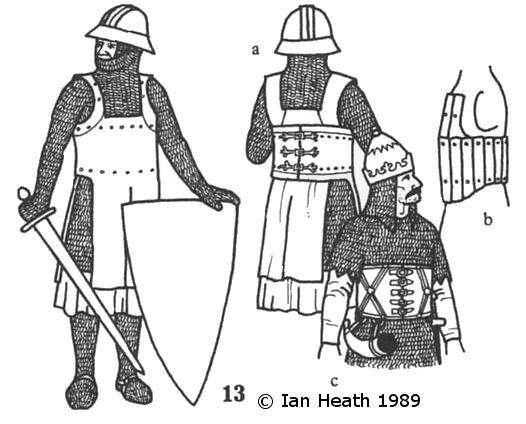|
|
MAN-AT-ARMS c.1280
An extract from Armies of Feudal Europe 1066-1300
by Ian Heath
[Based on Saint Maurice, Magdeburg Cathedral and Sleeping Guards at the Sepulchre, c.1300, Constance Cathedral.]

13. MAN-AT-ARMS c.1280
Based on German sculptures of the late-13th century in Magdeburg and Constance Cathedrals, this figure wears a coat-of-plates, basically a surcoat lined with iron laminae and as such the precursor of the 14th century brigandine.
The Magdeburg sculpture indicates that this particular type of coat-of-plates was a poncho-like construction in which the sides extending from the front, were wrapped round and secured by buckles down the middle of the back, as the rear view shows (13a).
Coats-of-plates of practically identical construction to the Magdeburg sculptures have been excavated on the site of the Battle of Wisby (1361), and 13b shows the arrangement of the plates in the excavated examples, classified as Wisby Type II.
See also figure 16.
Coats-of-plates are first mentioned in two Italian documents, a war-order of Florence (1259/60) and a mercenary contract from Massa, near Carrara (1267) both referring to the armour of German knights in the service of these cities.
In addition the new fangled ‘plate’ armour worn by German mercenaries at the Battle of Benevento in 1266 could only be coats-of-plates, and all the earliest sculptures, etc, depicting coats-of-plates are apparently of German origin.
Bengt Thordeman, the excavator of Wisby, therfore concludes that this type of armour was probably introduced into Europe via Germany by the Mongols, though no contemporary sources seem to describe such armour in use amongst the latter.
Interestingly, however, 13c depicts a very broad type of ‘belt’ of Polish origin which there is good reason to believe may be the forerunner of the coat-of-plates, consisting of several layers of leather, sometimes reinforced, and buckled at front or back.
It appears to have evolved in Poland as early as the beginning of the 12th century, this particular example being from a ms. of c.1100.
It seems more than probable, therefore, that the Germans adopted this form of armour during their campaigns against the Poles, improving on it until they arrived at the ‘coat-of-plates’ in the mid-13th century.
|

